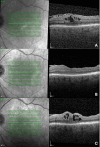Impact of epiretinal membrane peeling on steroid dependency in uveitic eyes: a retrospective analysis
- PMID: 40731032
- PMCID: PMC12306005
- DOI: 10.1186/s40942-025-00712-2
Impact of epiretinal membrane peeling on steroid dependency in uveitic eyes: a retrospective analysis
Abstract
Background: Secondary epiretinal membranes (sERM) are common in uveitis and often associated with cystoid macular edema (CME), which increases the need for anti-inflammatory treatment. While surgical removal can improve anatomical and visual outcomes, its effect on intraocular inflammation and steroid requirement remains unclear. This study evaluates whether vitrectomy with ERM peeling can reduce the need for postoperative steroid therapy in uveitic eyes.
Methods: This retrospective single-center study reviewed 67 eyes of 67 patients with history of uveitis who underwent sERM peeling between 11/2002 and 04/2023. Demographic data, uveitis classification (SUN), spectral domain optical coherence tomography (SD-OCT) findings, and pre-/postoperative steroid requirements were analyzed. Statistical significance testing was performed using a paired two-tailed t-test.
Results: Of the 67 eyes, 50.7% were right eyes, and 65.7% of patients were female. Mean age at timepoint of surgery was 63.1 ± 13.6 years, with 53.7% phakic eyes. Uveitis was classified as anterior (17.9%), intermediate (44.8%), posterior (31.3%), and panuveitis (6.0%). Steroid therapy was reduced in 28.4% of patients, remained unchanged in 56.7%, and increased in 14.9%. Preoperatively, cystoid macular edema (CME) was present in 41.4% of the 58 available SD-OCT scans. Postoperatively, retinal thickness, macular volume, and total retinal volume decreased significantly (p < 0.001). Postoperative CME was found in 31.3% in first postoperative SD-OCT and was newly observed in 6.0%, while 62.7% showed no CME.
Conclusions: ERM peeling in uveitic eyes does not guarantee functional improvement or a consistent reduction in steroid dependency. While approximately one-third of patients benefited from reduced steroid use-particularly those with preoperative CME-the majority showed no change, and a subset required intensified therapy due to postoperative inflammation or CME recurrence. Careful patient selection remains essential.
Keywords: Cystoid macular edema; Epiretinal membrane; Membrane peeling; Steroids; Uveitis.
© 2025. The Author(s).
Conflict of interest statement
Declarations. Ethical approval and consent to participate: The study was approved by the local Institutional Review Board (A 2022 − 0124) in Rostock and was conducted in adherence to the tenets of the Declaration of Helsinki. For this type of study formal consent is not required. Consent for publication: Not applicable, no data of individual person. Competing interests: The authors declare no competing interests.
Figures



Similar articles
-
Non-steroidal anti-inflammatory drugs versus corticosteroids for controlling inflammation after uncomplicated cataract surgery.Cochrane Database Syst Rev. 2017 Jul 3;7(7):CD010516. doi: 10.1002/14651858.CD010516.pub2. Cochrane Database Syst Rev. 2017. PMID: 28670710 Free PMC article.
-
Prophylactic non-steroidal anti-inflammatory drugs for the prevention of macular oedema after cataract surgery.Cochrane Database Syst Rev. 2016 Nov 1;11(11):CD006683. doi: 10.1002/14651858.CD006683.pub3. Cochrane Database Syst Rev. 2016. PMID: 27801522 Free PMC article.
-
Vitrectomy with internal limiting membrane (ILM) peeling versus vitrectomy with no peeling for idiopathic full-thickness macular hole (FTMH).Cochrane Database Syst Rev. 2013 Jun 5;(6):CD009306. doi: 10.1002/14651858.CD009306.pub2. Cochrane Database Syst Rev. 2013. PMID: 23740611
-
Non-steroidal anti-inflammatory agents for treating cystoid macular edema following cataract surgery.Cochrane Database Syst Rev. 2022 Dec 15;12(12):CD004239. doi: 10.1002/14651858.CD004239.pub4. Cochrane Database Syst Rev. 2022. PMID: 36520144 Free PMC article.
-
Anti-vascular endothelial growth factor combined with intravitreal steroids for diabetic macular oedema.Cochrane Database Syst Rev. 2018 Apr 18;4(4):CD011599. doi: 10.1002/14651858.CD011599.pub2. Cochrane Database Syst Rev. 2018. PMID: 29669176 Free PMC article.
References
-
- Fung AT, Galvin J, Tran T. Epiretinal membrane: a review. Clin Exp Ophthalmol. 2021;49(3):289–308. - PubMed
-
- Fang IM, Hsu CC, Chen LL. Correlation between visual acuity changes and optical coherence tomography morphological findings in idiopathic epiretinal membranes. Graefe’s archive for clinical and experimental ophthalmology = Albrecht von Graefes Archiv fur klinische und experimentelle Ophthalmologie. 2016;254(3):437–44. - PubMed
-
- Hubschman JP, Govetto A, Spaide RF, Schumann R, Steel D, Figueroa MS, et al. Optical coherence tomography-based consensus definition for lamellar macular hole. Br J Ophthalmol. 2020;104(12):1741–7. - PubMed
LinkOut - more resources
Full Text Sources

